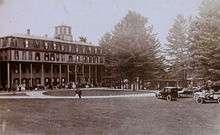Loon Lake, New York
| Loon Lake, NY | |
|---|---|
| hamlet | |
|
Loon Lake from Crusher Mountain | |
| Coordinates: 44°33′05.5″N 74°03′24″W / 44.551528°N 74.05667°WCoordinates: 44°33′05.5″N 74°03′24″W / 44.551528°N 74.05667°W | |
| Country | United States |
| State | New York |
| County | Franklin |
| Elevation | 1,800 ft (548.64 m) |
| Time zone | Eastern (EST) (UTC-5) |
| • Summer (DST) | EDT (UTC-4) |
Loon Lake is a hamlet in the northeast region of Adirondack Park in the US state of New York. The community is located 20 miles (32 km) northeast of Saranac Lake and 25 miles (40 km) north of Lake Placid on the east side of a lake also named Loon Lake.
Loon Lake was a socially prominent destination throughout the late 19th and early 20th centuries thanks to the Loon Lake House resort.
History
Blacksville
In 1848 Blacksville was the first attempt to settle the Loon Lake area. Gerrit Smith,the abolitionist, gave 200 acres to Willis Hodges, who was born free in Virginia, to settle a community with 10 families.
Unsatisfied with conditions, Hodges and the settlers became discuraged and abandoned the community after two winters.
Paul Smith
After Blacksville was abandoned two hotels were built, the Merrillsville Inn and Loverin Tavern. These hotels served loggers and hunters including Paul Smith. Smith, enjoying the area, bought 200 acres in 1852 on the North Branch of the Saranac River for $300. Here he built "Hunter's Home" and served doctors, lawyers, and other professionals. In 1858 Hunter's Home burned and Smith relocated the lower St. Regis and built a much larger hotel.
Loon Lake House
In 1878 Mary and Ferd Chase purchased 10 acres on a bluff overlooking Loon Lake and built a 31 room hotel, The Loon Lake House. The resort's instant success allowed the Chase's to expand operations, and by 1893 the Loon Lake House's capacity reached 500 guests. Eventually, the resort would expand to accommodate 800 guests across three hotel structures and 60 private cabins spread over the resort's 3,000 acres.

At this size, the resort had an expansive infrastructure that included two water systems, an underground sewer, an early electrical system, a dairy, vegetable and flower gardens, a large boat house, bowling alleys, and one of the Adirondack's first golf courses built in 1895. (The Loon Lake Golf Course was abandoned in 2003.) In its heyday it was sufficient as a small town; the resort also included a general store, post office, and a large and elegant train station. The train station originally serviced Chateaugay Railroad. In 1892 the New York Central Railroad completed their rail line allowing passage directly from New York City.
The beautiful landscape and lavishness of Loon Lake House attracted many public figures of the period. Presidents Grover Cleveland, Benjamin Harrison, and William McKinley enjoyed stays at the Loon Lake House during their presidencies. Wealthy families of the period, including the Vanderbilt's, Whitney's, Rothschild's, Rockefeller's, and Guggenheim's regularly stayed at the resort. Additionally, popular literates including Irving Berlin, George Gershwin, Theodore Dreiser, Sir Arthur Conan Doyle,and Oscar Wilde vacationed at the Loon Lake House.
The Chases owned and managed the hotel from construction in 1878 until 1929. Business dwindled after the stock market crash of 1929, forcing Mary Chase to sell the resort. In 1956, the primary building burned. The remaining assets, including the grounds and cabins, were auctioned off in 1957.
Loon Lake
Loon Lake is fresh water and approximatively 3 miles long. The lake is positioned between Look Out and Loon Lake Mountains.

Cultural allusions
- Loon Lake (novel) by E.L. Doctorow, is a stream-of-consciousness styled work. A large private estate on the lake is the main setting for this 1930's Depression period story.
- Loon Lake is mentioned in Chapter XLII of Theodore Dreiser's The Titan.
Sources
- Beckwith Smith III, Karl Loon Lake: An Introduction
- Collins, Geradine. The Biography and Funny Sayings of Paul Smith, Paul Smiths College, Paul Smiths, NY. 1965.
- http://loonlakehoa.org/RR%20NYT%2012Jul1888.pdf
- "THE PRESIDENT AT LOON LAKE.; MRS. HARRISON CARRIED FROM THE TRAIN TO HER CARRIAGE.". The New York Times. July 8, 1892. Retrieved July 2, 2014.
| |||||||||||||||||||||||||||||||||
